Here's a shot of the starboard stern hatch. This gives access to remove the fuel tank, as well as some storage for another dry box. This dry box has some bottled water, food and other survival gear in it. Also, note the inline water strainer located on top of the fuel tank. I figure it's a lot easier to lift this hatch to check my strainer, than having to remove the engine cowling, and stick my hand down amongst all the razor blades (hose clamps)
View attachment 6
This one shows the front of the engine. You can see how there is a 'bulkhead' at the front of the engine. The water has to be this high on the deck to flood into the engine compartment, and even then, because the cowling overlaps this bulkhead and there is a seal all the way around the cowling, that isn't likely to happen. because the round object right in front of the bulkhead is a cover with a strainer screen for a 500 GPH electronic bilge pump. Also contained in this area is the siphon bilge pump that hooks to the jet pump, so it is pumping whenever the engine is running.
View attachment 5
I set the engine back as far as possible by cutting the driveshaft shorter, but even so, I couldn't get it back that last 2 inches so the entire engine would be behind a bulkhead.
A shot of the engine from the starboard side.
View attachment 4
On the 2 stroke design, both fuel tanks were located all the way to the rear. But, because of how the muffler comes off the HO engine, the fuel tank had to be located forward. As a result, the hatch for the fuel tank access had to have the filler neck hole cut into it, so, it is not a removable hatch like the starboard side, it is riveted in place. The vent to the rear is for the blower, and because the slot faces forward, it also acts as an air intake while underway. This was the location of the original filler neck for the port side fuel tank. When I moved the tank forward, I utilized this existing hole for the blower by enlarging it to 4" diameter.
The vent in front of that faces to the rear, and allows air to flow out. The only reason the forward vent is there to begin with is because of the height of the fuel pump, I had to raise my deck up about an inch or so to give clearance for the wire harness plug. If not for that, this vent would not be there.
A shot from the port side. You can see the driveshaft coupler guard, I fabricated this from some 1/8" aluminum sheet, bending it in my brake. I used yamaha's pre-existing bolt holes for their coupler guard to bolt a set of clips to, for the guard to slide down onto. Works pretty good.
View attachment 3
Although the cowling sticks up a good 6 inches higher than the rear reck of the boat, when you look at it from the side, it's not really that noticeable, and the 'High Output' lettering breaks it up, so it doesn't look as big (the lettering is factory Yamaha, for their SX230 jetboat)
View attachment 2
Here's a shot of the stern, that shows off the platform. The platform attaches with 4 bolts.
View attachment 1
A shot of the transom, showing the jet pump tunnel with the rubber skirting that acts as a sound baffle.

































































